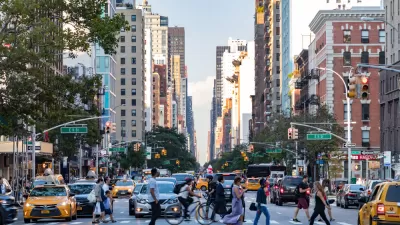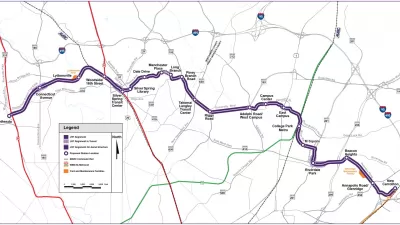As the real estate market comes back to life, walkable urbanism is poised to become the dominant mode of development across America. Emily Badger explains why Washington D.C.'s land use evolution portends the future of cities everywhere.
Once seen as a niche real estate market, walkable urbanism is poised to become the real estate market in America. So says George Washington University professor Christopher Leinberger, who will present his research on the growth of walkable urbanist development in Washington D.C. at a ULI conference on the topic next week. For Leinberger, the trends he's observed in Washington, which "now leads the nation with 43 distinct neighborhoods [he] has identified as 'regionally significant walkable urban places,'" will be coming soon to cities everywhere.
"Less than 10 percent of the entire metropolitan land mass is where
development wants to go over the next generation," Leinberger says. "We
don't need to add another square foot – or, in the case of sprawl,
another square mile – of land to the metropolitan area. We've already
urbanized as much as we need to."
"It helps his argument that he's talking in market trends and not moral
imperatives," writes Badger. "Much of the conversation around 'walkable urbanism' sounds
almost paternalistic to suburban ears, as if everyone should and must
decamp to high-rise condos above a Whole Foods."
"He isn't advocating that suburbanites move downtown. If he's imploring
anyone to action, it's the builders and real estate developers who don't
seem to have picked up on shifting market demand yet, and the
policymakers who have the power to clear obstacles to this kind of
development (for starters, by promoting multi-modal transportation and
mixed land use)."
FULL STORY: The Next Major Real Estate Cycle: Walkable Urbanism?

Planetizen Federal Action Tracker
A weekly monitor of how Trump’s orders and actions are impacting planners and planning in America.

Map: Where Senate Republicans Want to Sell Your Public Lands
For public land advocates, the Senate Republicans’ proposal to sell millions of acres of public land in the West is “the biggest fight of their careers.”

Restaurant Patios Were a Pandemic Win — Why Were They so Hard to Keep?
Social distancing requirements and changes in travel patterns prompted cities to pilot new uses for street and sidewalk space. Then it got complicated.

DC Area County Eliminates Bus Fares
Montgomery County joins a growing trend of making transit free.

Platform Pilsner: Vancouver Transit Agency Releases... a Beer?
TransLink will receive a portion of every sale of the four-pack.

Toronto Weighs Cheaper Transit, Parking Hikes for Major Events
Special event rates would take effect during large festivals, sports games and concerts to ‘discourage driving, manage congestion and free up space for transit.”
Urban Design for Planners 1: Software Tools
This six-course series explores essential urban design concepts using open source software and equips planners with the tools they need to participate fully in the urban design process.
Planning for Universal Design
Learn the tools for implementing Universal Design in planning regulations.
Heyer Gruel & Associates PA
JM Goldson LLC
Custer County Colorado
City of Camden Redevelopment Agency
City of Astoria
Transportation Research & Education Center (TREC) at Portland State University
Camden Redevelopment Agency
City of Claremont
Municipality of Princeton (NJ)





























